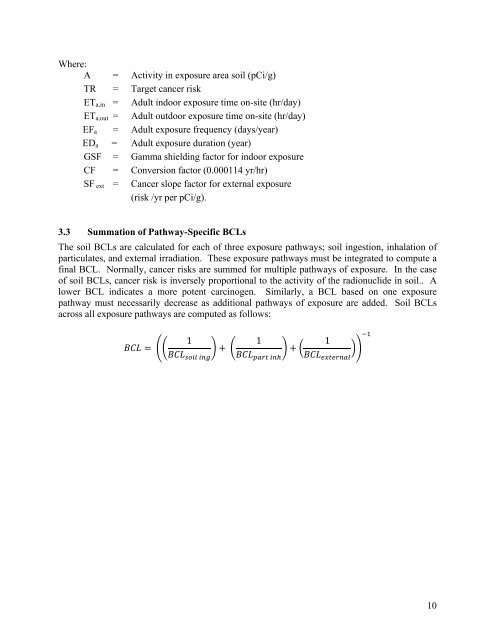user's guide and background technical document for the nevada ...
user's guide and background technical document for the nevada ...
user's guide and background technical document for the nevada ...
Create successful ePaper yourself
Turn your PDF publications into a flip-book with our unique Google optimized e-Paper software.
Where:<br />
A = Activity in exposure area soil (pCi/g)<br />
TR = Target cancer risk<br />
ETa,in = Adult indoor exposure time on-site (hr/day)<br />
ETa,out = Adult outdoor exposure time on-site (hr/day)<br />
EFa = Adult exposure frequency (days/year)<br />
EDa = Adult exposure duration (year)<br />
GSF = Gamma shielding factor <strong>for</strong> indoor exposure<br />
CF = Conversion factor (0.000114 yr/hr)<br />
SF ext = Cancer slope factor <strong>for</strong> external exposure<br />
(risk /yr per pCi/g).<br />
3.3 Summation of Pathway-Specific BCLs<br />
The soil BCLs are calculated <strong>for</strong> each of three exposure pathways; soil ingestion, inhalation of<br />
particulates, <strong>and</strong> external irradiation. These exposure pathways must be integrated to compute a<br />
final BCL. Normally, cancer risks are summed <strong>for</strong> multiple pathways of exposure. In <strong>the</strong> case<br />
of soil BCLs, cancer risk is inversely proportional to <strong>the</strong> activity of <strong>the</strong> radionuclide in soil.. A<br />
lower BCL indicates a more potent carcinogen. Similarly, a BCL based on one exposure<br />
pathway must necessarily decrease as additional pathways of exposure are added. Soil BCLs<br />
across all exposure pathways are computed as follows:<br />
<br />
1<br />
<br />
<br />
1<br />
<br />
<br />
1<br />
<br />
<br />
<br />
10









![Adobe PDF File 69 Pages [15MB]](https://img.yumpu.com/18024842/1/190x143/adobe-pdf-file-69-pages-15mb.jpg?quality=85)







